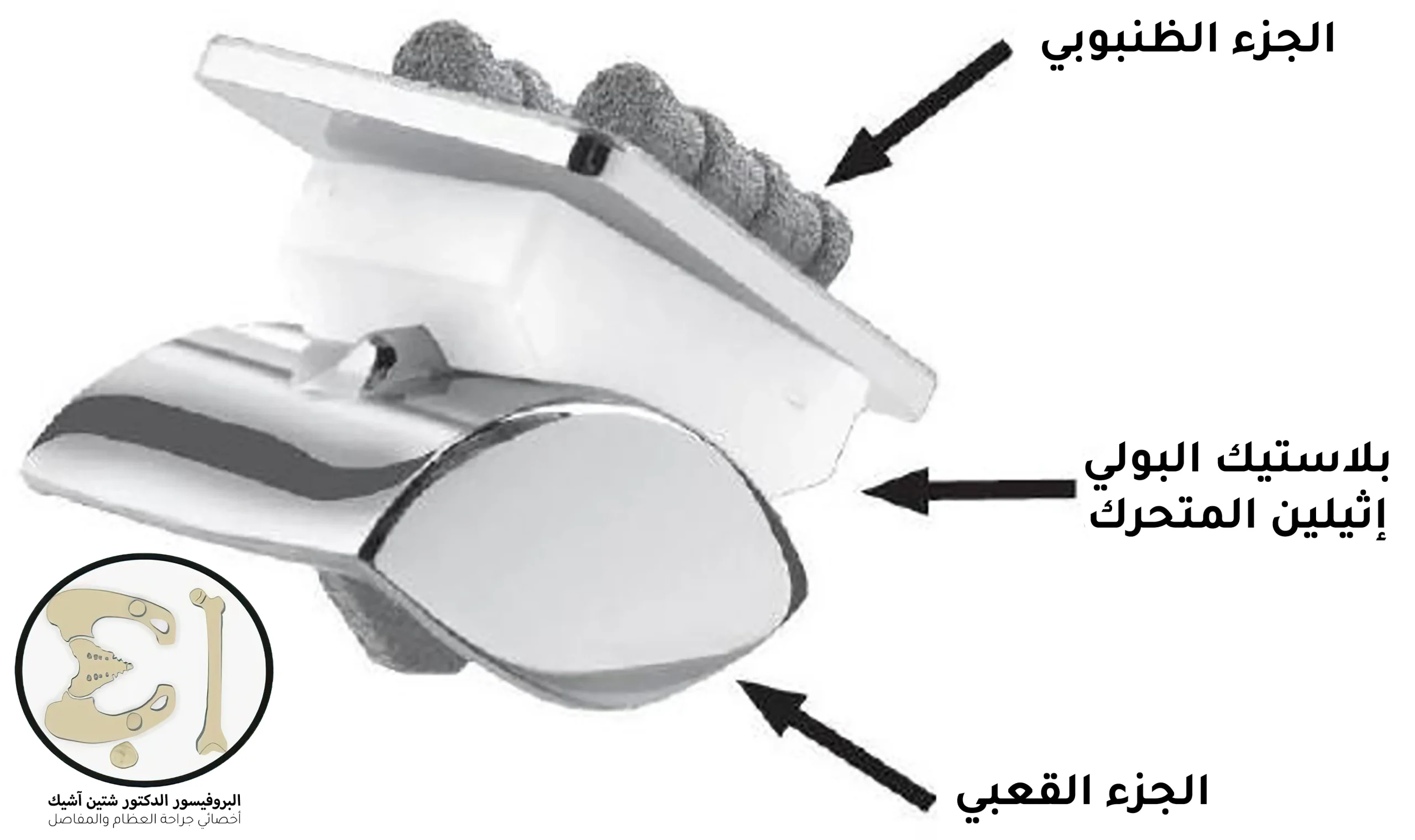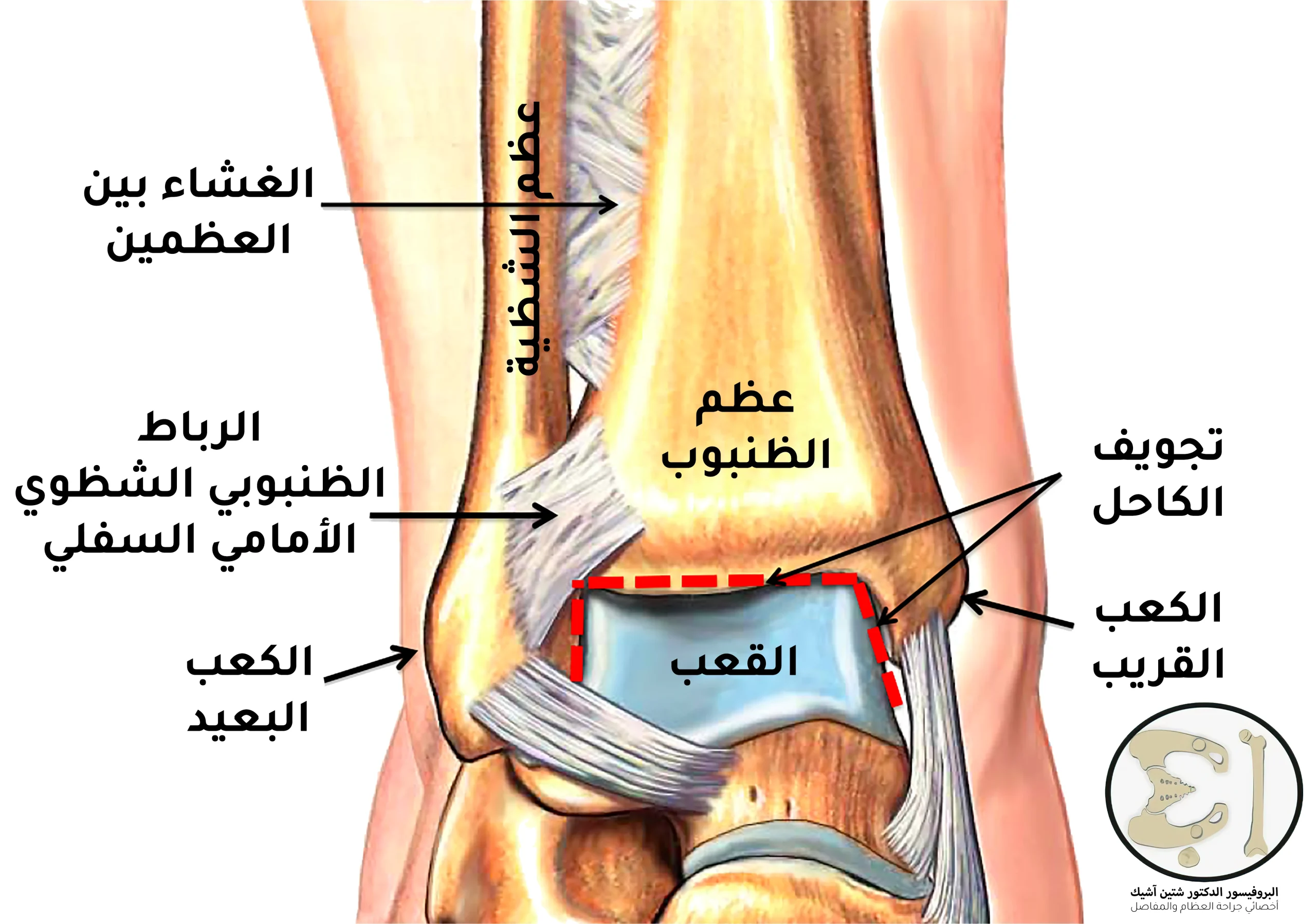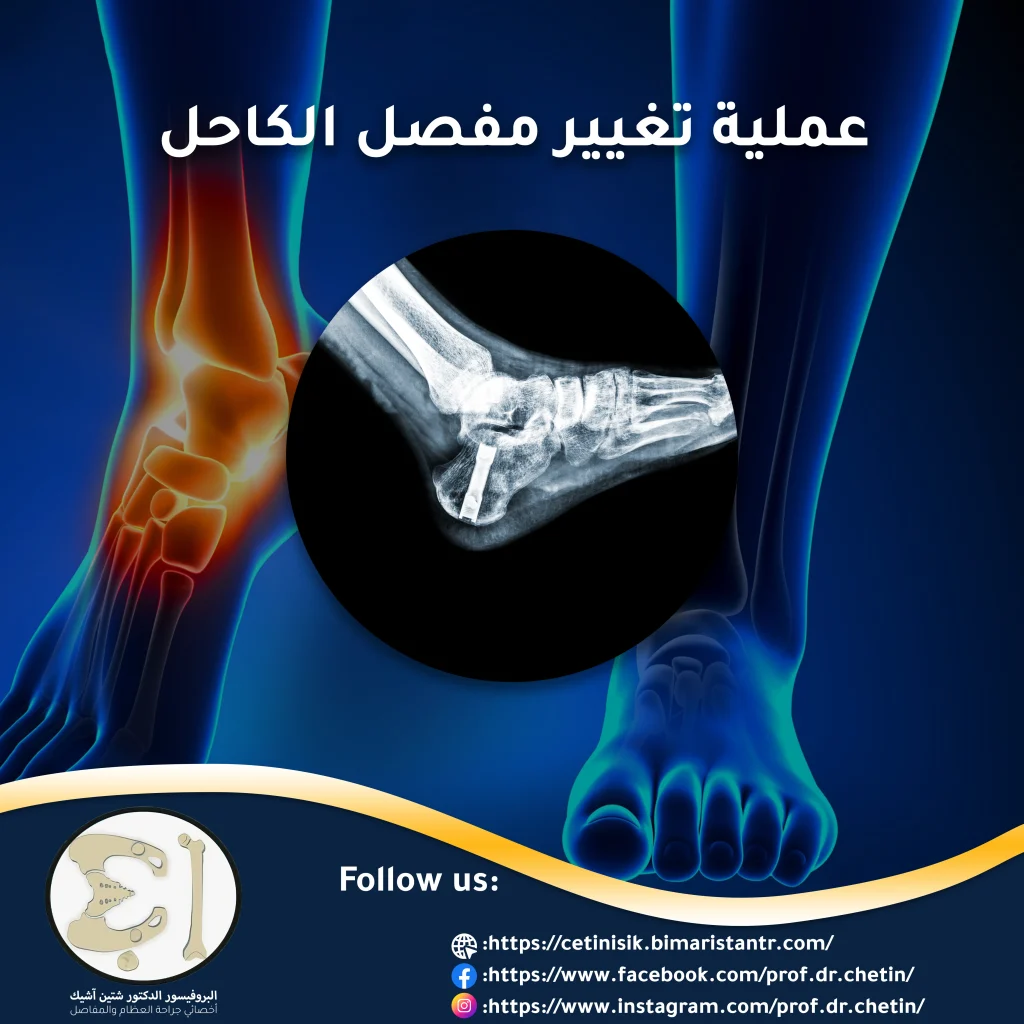Ankle joint replacement surgery is one of the essential operations to treat arthritis in the foot in its final stages, as sometimes the only option is to replace the joint after the failure of all conservative treatments.
What is the operation to replace the ankle joint?
Total joint replacement, also called ankle arthroplasty, is a surgical procedure in which the damaged tissues of the ankle are replaced with artificial elements such as metal and plastic. These elements work together to move the joint as normally as possible.
The procedure usually allows the patient relief from pain andAnkle swelling Especially when he suffers from osteoarthritis for a long time and does not benefit from conservative treatment, including medications and painkillers.
The success rate of ankle replacement surgery may not be the same as in the knee, shoulder, etc., for many reasons, the most important of which is the exposure of the ankle joint, in particular to tremendous pressure compared to its small articular surface, in addition to the fact that the ankle has three articulating surfaces that must be replaced instead of two surfaces, as in the pelvic joint, for example.
In ankle replacement surgeries, cylindrical or spherical prostheses are used, and they are made of cobalt, chromium, and a blend of ultra-high molecular weight polyethylene (i.e., plastic).

Foot joint structure
The ankle is one of the body's synovial joints with a saddle-cylindrical shape and consists of the talus bone, the tibia, and the fibula. It is characterized by the presence of three articular surfaces that make simulating its natural structure when manufacturing prostheses a great challenge, namely:
- The upper surface of the talus bone: It has a distinctive shape, rounded at the back, and the tibia or shin bone rests on it.
- The lower surface of the tibia: is concave to match the bone of the upper surface of the heel.
- The lower surface of the fibula: The smallest of the articular surfaces, it is inclined and contributes significantly to the stability of the joint during movement.
The last bones, when combined, form what is called the heels, and each foot has two heels, the first close to the body or proximal, and the other is in the opposite direction or distal.

Foot joint ligaments
The ligaments of the joint of the foot are similar to rubber bands, as they connect the elements of the joint, where they fuse to form a unique cover that contributes to maintaining the stability of the joint, in addition to its contribution to protecting the ankle from an injury that may lead to severe damage to it.
There are three groups of ligaments in the ankle joint: the proximal, distal, and ligamentous groups. It may occur Torn ankle ligaments In any group of them, when performing violent activities, patients usually complain of severe pain after this happens.

People who need ankle replacement surgery
Patients require ankle joint operations if they suffer from severe postural-related arthritis that leads to symptoms such as acute pain, inflammation, andand stiffness . This will lead to difficulty in moving the foot and ankle, and among the most critical forms of arthritis that may lead to a joint change in the long term:
- Osteoarthritis.: Is a type of arthritis associated with degenerative changes in the cartilage's affected joint's cartilage and is common in the elderly.
- Rheumatoid Arthritis: A severe autoimmune disease that occurs in several joints and requires early treatment.
- Post-traumatic arthritis: The damaged articular surface is exposed to rupture and increases the possibility of osteoarthritis at an early age with time.
Preparing for an ankle replacement surgery
Orthotics and joint replacement operations require patients to have sufficient awareness and knowledge before deciding to undergo surgery, and the doctor usually recommends:
- Start physical therapy
- stop smoking
- Stopping some medications
The family and relatives can be informed about upcoming events, such as undergoing surgery, being absent from work, etc., as it is usually advised to avoid walking after the ankle joint replacement surgery, and the doctor may also suggest a simple daily routine that does not include strenuous activities.
Surgical technique in ankle replacement surgery
The steps for installing artificial joints in the foot are summarized as follows:
- Anesthesia, which is usually general.
- Vital signs are monitored during the arthroscopy by a specialist throughout the procedure.
- After cleaning the surgical workplace well with sterilizers, a deep surgical incision is made in the ankle and sometimes the foot as well.
- The surgeon removes the damaged parts of the bony surfaces while preserving as much as possible the healthy cartilage tissue.
- After that, the metal parts are placed and fixed to the bony surfaces accurately, and a type of bone cement may be used here to stabilize the implant.
- This is followed by inserting the plastic part, which is the most important part in order for the movement of the artificial joint to be smooth.
- Normal shape and healthy structures are preserved as much as possible, the wound is closed, and the patient is awakened.
Surgical intervention in the ankle joint replacement operation is usually done from the front, but in patients who underwent operations on the foot, the entrance can be modified slightly by making an alternative surgical incision to ensure proper healing of the previous wound and to achieve the required cosmetic results, especially in women.
Many tools are used for different purposes, such as a surgical endoscope and a toothed bone saw. The surgery also takes into account the presence of important structures that pass near the ankle joint, such as vessels and nerves. The method currently used is based on complex steps that make this operation one of the difficult joint surgeries that require an expert surgeon.
It is worth noting that foot deformities that may occur and cases of instability are managed with a second operation or within the same operation, but after placing the artificial joint in its designated place, removing damaged tissues and other basic procedures in the operation.

Ankle joint replacement surgery does not take more than an hour and patients can stay in the hospital for a day or two after the operation, and sometimes they are discharged on the same day if their condition permits.
Post-ankle replacement surgery
After waking up from anesthesia, patients notice that the foot is raised above the thigh level and fixed using a special artificial gypsum in the hospital. Doctors do not require a special diet after the operation, but they may need to take x-rays of the artificial joint to verify its position.
Often a splint is placed for several weeks and then a special bandage. There are also specific instructions on how to move the foot so that the foot can heal quickly. It is useful to elevate the foot after the operation for several weeks. Finally, you cannot put your full weight on the joint before several months have passed.
Foot joint exercises
There is a special section of physiotherapy applied to the ankle joint and the most important exercises include:
- dribbling
- calf stretch
- Heel stretch
- Ankle rotation
- Ankle raise
Walking after ankle replacement surgery
The patient must walk immediately after ankle replacement surgery to ensure the effectiveness of the artificial joint replacement.

My story with foot joint replacement
Patricia Johnson felt she had been given a second chance at life after her ankle replacement surgery. When she tripped and fell on the ice in 2000, her right ankle was completely torn and she thought she would never walk again.
Pat underwent an emergency operation to repair her ankle, and after her bones healed, she felt severe pain caused by the abnormal growth of the bones and the presence of metal plates to stabilize the joint. Even after removing the plates, spreading the excess bone, and refraining from exercising, her ankle pain did not subside to the point that walking became torture.
Despite her commitment to conservative treatment, she did not benefit from it, and joint stabilization surgery was not a comfortable option for her because she enjoys a lifestyle full of activity and movement, so she underwent an ankle joint replacement in 2008.
Pat says:
“I have gone from a state of chronic pain that does not go away as soon as I stand up to a more energetic lifestyle where I can do whatever physical activities I like, I do not feel that there is a challenge now, I just feel grateful.”
Pat believes that appropriate action research andSurgical expertise The good guys can really change the world, at least for someone who has a sore ankle that prevents him from living his life as he loves.
Alternatives to foot joint replacement
Ankle joint pain and injuries can be managed in a natural way. As the popular saying goes, some prevention methods are better than many cures. There are many natural ways through which joint pain and degeneration can be prevented.
Foot joint physical therapy
Taking some simple measures may relieve ankle pain and prevent it from progressing to the point of needing a joint replacement. These measures include:
- Maintaining an appropriate weight: Excess weight contributes directly to increased pressure on the body-bearing joints, which accelerates their degeneration and increases their pain intensity.
- Strengthening the muscles supporting the ankle joint: This prevents injuries.
- Stop moving when feeling pain: Never ignore the pain and take a break.
- Adequate warm-up before exercising: Warm-up exercises may prevent injuries, especially of muscles and soft tissues.
treatment Foot arthritis With herbs
Many patients find traditional medicine a suitable option sometimes when their ankle joint pain is mild and can be managed with conventional herbal recipes, as the most critical herbal alternatives used include:
- Borage flower oil
- Turmeric
- Cat's claw
In addition to many natural herbal materials, we have covered this topic in an article on our website.
Side effects of ankle replacement surgery
Ankle joint replacement, whether it is a total or partial replacement, is not without risks and side effects, including:
- Infection of the ankle or foot joint.
- Damage to the adjacent nerves in the ankle joint.
- Bleeding after joint replacement surgery.
- Clot formation.
- Improper fusion of the bones.
- Deformity of the foot joint.
- Osteoarthritis in adjacent joints.
- Deterioration of the components of the artificial ankle joint, which requires the replacement of the joint again.
People who shouldn't undergone ankle replacement surgery
There is a segment of patients whose treatment options must be considered before undergoing ankle replacement surgery, and they are:
- Young patients (under 55 years of age).
- Who did not suffer severe deformities in the ankle.
- Their ankle joint is not stable.
- The joint has had inflammation before.
- Their heel bone crumbled.
You can Contact us to learn more about ankle replacement surgery and its side effects.
Sources:
- Johns Hopkins Medicine
- National Health System UK
- Ortho Info
- ScienceDirect AI-Generated Literature Reviews
- Aerzteblatt.de
Common questions
Inflammation occurs, and this condition goes away spontaneously after several weeks.
Many reasons differ according to the place, as there is a pain in the joint of the foot, pain in the metatarsus after walking and when sleeping, and spraining the joint and tearing the ligaments.
Moving the ankle joint quickly or putting pressure on it is only sometimes recommended. The excessive crackling of the joint may indicate a problem that requires a medical review.
He cannot drive for several weeks due to a post-joint replacement splint.




